 By Bob Currie, Recreational Boating Safety Specialist
By Bob Currie, Recreational Boating Safety Specialist
U. S. Coast Guard Auxiliary Station Galveston Flotilla
When trying to decide what type of boat to purchase, one of the most important discussions should be about the hull shape that is best suited for the type of boating you will do. This column will discuss the pros and cons of the most common hull types used for recreational powerboating.
The Station Galveston Flotilla of the US Coast Guard Auxiliary operates out of the USCG Station Galveston base on Galveston Island. They aid the Coast Guard by providing maritime observation patrols in Galveston Bay; by providing recreational boating vessel safety checks; and by working alongside Coast Guard members in maritime accident investigation, small boat training, providing a safety zone, Aids to Navigation verification, in the galley, on the Coast Guard Drone Team and watch standing.
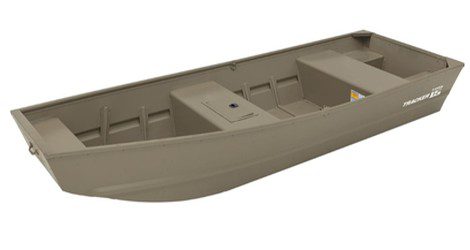
Flat Bottomed Boats- The Jon Boat
The Jon boat is one of the simplest, most economical, and most stable boats, provided it is used on calm waters. They are generally small boats designed to carry one or two people, although large jon boats have larger capacities. Jon boats are often the first type of boat bought by boaters operating on lakes and calm rivers. They can also be great saltwater marsh boats. They generally do not handle rough water well. Most jon boat motors are tiller drive, which means the operator must sit at the back of the boat to operate the engine and steer. Because of the flat bottom, handling when crossing other boat wakes and in rough water is less than smooth and could result in ejection of passengers if made at speed. Most tiller engines do not have electric trim, so when making turns a reduction in speed will help the boat hold the water better and cut down on sliding. If the engine does have electric trim, then trimming down will generally prevent sliding without having to reduce speed.
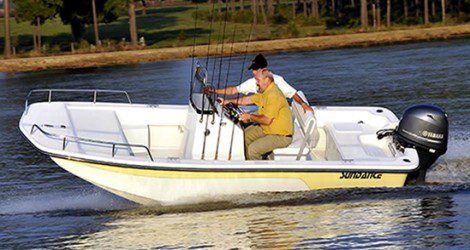
Flat Bottomed Boats- The Skiff
Flat bottomed skiffs are excellent choices for inland waters due to their shallow draft. They are often of the center console design, which allows much better weight distribution than a jon boat with a tiller motor. Their handling in calm water is hard to beat. The flat bottom helps the boat to get up on plane quicker than the same size boat with a V hull. Because of the flat hull shape, skiffs do not handle choppy water as well as a V hull design. Although they can be used offshore, the operator should gauge the possibility of increasing wave size as the winds increase during the day. The skiff makes a stable platform for fishing from the bow or stern, and due to the amount of hull in the water they have a very shallow draft compared to other hull designs. The flat bottom is a con when it comes to breeching large waves; the bow tends to take on water rather than disperse it to the side as is the case with a V hull. Trimming down the engine when making turns with a flat bottom boat helps prevent sliding.
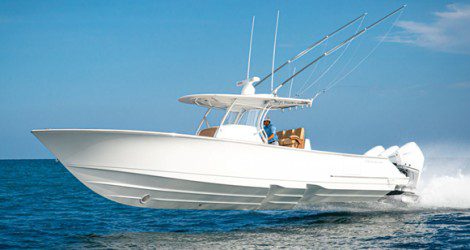
Deep V Hull Boats
If you want to get from Point A to Point B regardless of water conditions (up to a point, of course), the deep V hull is the boat for you. While flat bottom boat owners like flat bottom boats for their shallow draft and stability, deep V hull boat owners are looking for a smoother ride in choppy water. The shape of the hull deadrise determines how well a V shaped hull slices through pounding waves. Deadrise is defined as the angle between a horizontal plane and the hull surface. A boat with a lot of deadrise is a boat with a deeper, sharper V shaped hull that can cut through the waves rather than run over them like a flat bottom boat. A variation of the deep deadrise V hull is the deep deadrise hull with chines. The chine of a boat refers to the change in angle in the cross-section of the vessel’s hull. Some boats have multiple chines, Multiple chines are good for high speed boating turns. As a boat gains speed it will lift up on plane. With less of the hull in the water the boat becomes laterally unstable. This instability allows the hull to pivot along its length and manages to stabilize turning at high speeds.

A deep V racing boat may have a deadrise of 50 degrees at its bow and 20 degrees at its transome. The tradeoff of cutting through chop with ease is the decrease in stability when moving slowly or not moving at all. Because a deep-V hull tends to fling water upward rather than outward as it slices through waves, a cross wind will make for a wet ride at least for one side of the boat.
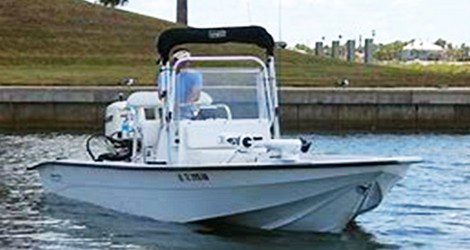
Modified-V Hull Boats
A modified-V hull is a mix of flat bottom and deep V hull. It is flat in the back but runs to a narrow V shape at the bow. It is one of the more popular designs for smaller recreational boats. The flat back adds speed while the V at the bow ensures good handling in light chop. It is a fast design that is stable, safe, and handles well, but it is not the best at any of those things. My boat has a modified-V hull, and it handles chop quite well. The shape will split large waves yet it will ride across the top of light chop, and it generally provides a dry ride in both instances if handles properly. Timing the waves is critical to having a fairly smooth and dry ride.
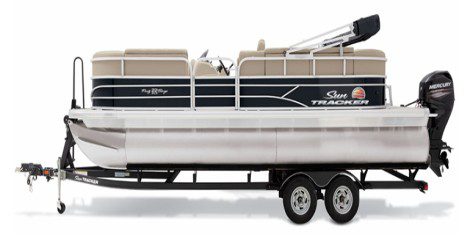
Pontoon Boats
Pontoon hulls comprise two or more metal tubes. Those tubes, or pontoons, can have different cross section shapes. The strongest shape is completely cylindrical. Other shapes include U-shaped and elliptical. The larger the diameter of the pontoon the better. Two-hull pontoon boats are generally low horsepower boats with top speeds in the 20 mph range with engine horsepower ranging from 25-60, with the most common engine size in the 40-50 hp range. Pontoon boats with three pontoons can take much larger engines and can reach 50 mph on smooth water. I owned a pontoon boat for years. I wanted a center console fishing boat, but my wife said no, we have many grandkids and she wanted something that could haul them around my home lake (Lake Belton). I got a fishing model with two captain seats up front and a live well. It turned out to be a great fishing boat if you weren’t in a hurry to get to a fishing spot.
Pontoon boats are quite stable in smooth water and will turn quite well at low speeds. Pontoon boats will plane quite easily as long as the weight is evenly distributed. If everyone is at the back of the boat you will have trouble getting on plane. My boat had a weight distribution sticker on the console. One good thing about a pontoon boat is that you don’t have to worry about a plug. When I sold my pontoon boat and bought a center console, I had a couple of episodes where my automatic bilge pump came on as I was launching the boat. I now have a tattoo on my left arm that says Check the Plug. Although a pontoon boat may seem to handle rough water well, rough water places greater strains on the hull design than it does other hull designs. You don’t want to lose a pontoon running in rough water. The framework is designed for calm water rather than running out to the rigs. Wind affects pontoon boats more than other hull designs since they have 90-95% of the boat above the water line, and this can make it rough for close handling situations such as coming into the dock or loading the boat on the trailer. For that reason, if you have your Bimini top up you should lower it before coming into the dock or ramp. A large platform invites people to move about while underway (especially grandkids). Be sure to instruct your passengers to remain seated while underway.
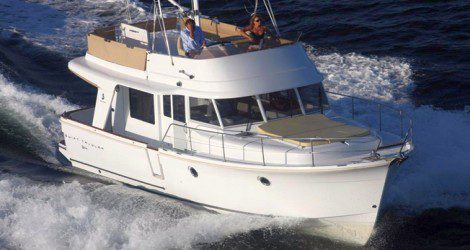
Semi-Displacement Hull Boats
Another name for semi-displacement hulls is semi-planing hulls. Semi-displacement hulls are between displacement hulls and planing hulls for speed, efficiency, and ride. These hulls are designed to half-plane at lower speeds (15-20 knots) than full planing hulls. They require less power than a full displacement hull to reach the same speed. They are steady and seaworthy yet faster than a displacement hull.
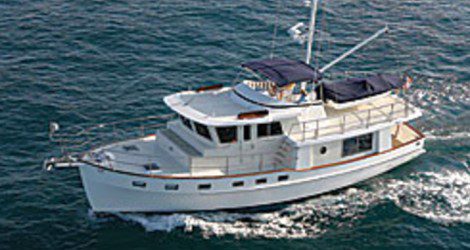
Displacement Hull Boats
Displacement hull boats will not achieve plane. Instead, they plog through the water. Displacement hull boats move through the water by pushing the water aside and are designed to cut through the water with very little propulsion. The biggest limitation of these boats is their speed, which is constrained to that of an open ocean wave of the same length as the hull at the water line. Displacement hull boats are great for operating in rough waters. They handle rough seas much better than planing hulls. For ocean crossing capability there is no substitute for a displacement hull. A problem occurs when boating manufacturers begin adding multiple levels to the superstructure, the portion of the boat above the gunnels. High superstructures tend to make the displacement hull boat more susceptible to capsizing due to strong wind and wave action on the superstructure.
Summary
Prospective boat owners have many choices of hull designs. They need to figure out where they will primarily operate and use that to decide which type of hull will suit their purpose. Although each type of hull may be used in different situations, each type has its limitations which must be considered when making a purchase decision.
For more information on boating safety, please visit the Official Website of the U.S. Coast Guard’s Boating Safety Division at www.uscgboating.org. Questions about the US Coast Guard Auxiliary or our free Vessel Safety Check program may be directed to me at [email protected]. SAFE BOATING!
[Nov-23-2021]

 Posted in
Posted in 























